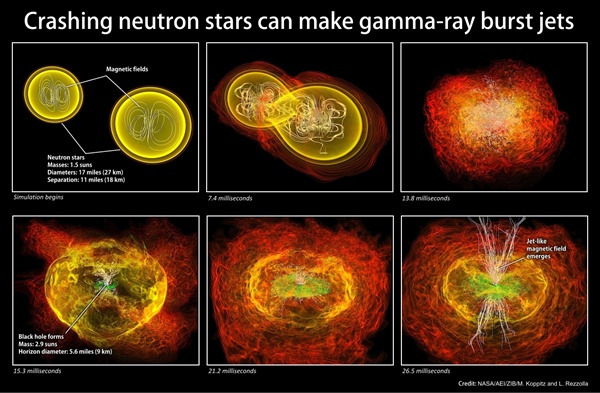Astronomers May Have Spotted Another Neutron Star Merger
Posted on Categories Discover Magazine

Neutron star mergers are believed to generate jets that could produce gamma-ray bursts detected at Earth. This diagram shows each step of the merger process, including the formation of a black hole when the two neutron stars collide and the resulting jet. (Credit: NASA/AEI/ZIB/M. Koppitz and L. Rezzolla)
Co-author Geoffrey Ryan of the University of Maryland (UMD) and the Joint Space-Science Institute, who called the events “cosmic look-alikes,” said, “They look the same, act the same and come from similar neighborhoods, so the simplest explanation is that they are from the same family of objects.”
However, for all their similarities, GW170817 and GRB 150101B do have some key differences. GW170817 was also detected via gravitational waves, while GRB 150101B was not. Without this key information, astronomers cannot be sure that GRB 150101B resulted from the merger of two neutron stars; it may have been the merger of a black hole and a neutron star instead. Additionally, GRB 150101B’s host galaxy is much farther than GW170817’s — the former lies 1.7 billion light-years away, while the latter is only 130 million light-years distant. But because GRB 150101B occurred so far away, the team says, even if LIGO had been in operation when it was seen, the observatory would likely not have detected gravitational waves.
Building a Database
The first step toward better understanding these events is finding more of them. And, the team says, it’s possible astronomers have seen others, but simply weren’t able to identify them because they lacked data in other wavelengths. Though astronomers have detected many gamma-ray bursts, these events can be difficult to pinpoint exactly on the sky without data from X-ray or optical observations. As faster follow-up observation with multiple telescopes becomes more the rule than the exception, astronomers could soon double their database of neutron star mergers again.
But it’s important to keep the initial differences between the only two known events in mind. GW170817 and GRB 150101B might not be as similar as they seem, and that could be important. “If the next such observation reveals a merger between a neutron star and a black hole, that would be truly groundbreaking,” said co-author Alexander Kutyrev, who is also associated with both UMD and Goddard Space Flight Center. “Our latest observations give us renewed hope that we’ll see such an event before too long.”
One thing is for sure: As detectors and detection techniques improve, astronomers are sure to see more astronomical events at many wavelengths, providing an ever-clearer picture of how our universe works. The better able astronomers are to identify the types of emission (such as light or gravitational waves) associated with an event, the more of them they will spot using many different techniques. “We’ve been able identify this kilonova without gravitational wave data,” Troja said, “so maybe in the future, we’ll even be able to do this without directly observing a gamma-ray burst.”